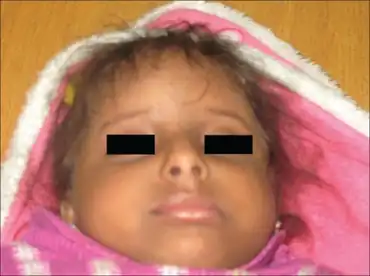Kenny-Caffey syndrome
| Kenny-Caffey syndrome | |
|---|---|
| Other names: Kenny syndrome | |
 | |
| Micrognathia, upslanting, deep-set eyes ,low set ears | |
Kenny-Caffey syndrome (KCS) is a genetic condition causing short stature, hypermetropia, microphthalmia, and skeletal abnormalities.[1] Individuals with the condition have long bones that are thinner than normal while the cortex is thickened. Hypocalcemia is also common, particularly in the neonatal and infantile period, and is related to the skeletal anomalies, as the parathyroid hormone (PTH) is not properly regulated in this condition.[2] The condition was originally described by Kenny and Linarelli in 1966 in a mother and her son.[3] In 1967, Caffey, a pediatric radiologist, described the radiographic aspects of same family.[4] The condition was since called the Kenny-Caffey syndrome. The nosology got confused when a somewhat similar but recessively inherited condition was also called "Kenny-Caffey syndrome".[5] This recessive condition, that (unlike than the original dominant Kenny-Caffey syndrome) includes intellectual disability, should be called the Sanjad-Sakati syndrome or Hypoparathyroidism-Retardation-Dysmorphism Syndrome.[6][7]
KCS is autosomal dominant and caused by specific monoallelic genetic variants in the gene FAM111A.[8] [2]It affects males and females in equal proportions, and it is most often sporadic, but can be transmitted by an affected mother to their offspring (like in the original family described by Kenny and Caffey).[1]. Other genetic variants in the same gene FAM111A may produce the related, but more severe disorder, osteocraniostenosis.[9]
Treatment may be required to control hypocalcemia and to correct the ocular refraction anomalies. [1]
References
- 1 2 3 "Kenny-Caffey Syndrome". Archived from the original on 2021-03-20. Retrieved 2021-10-25.
- 1 2 "OMIM Entry - # 127000 - KENNY-CAFFEY SYNDROME, TYPE 2; KCS2". www.omim.org. Archived from the original on 14 April 2020. Retrieved 13 March 2019.
- ↑ Kenny, F.M., and Linarelli, L. (1966). Dwarfism and cortical thickening of tubular bones. Transient hypocalcemia in a mother and son. Am. J. Dis. Child. 111, 201–207
- ↑ Caffey, J. (1967). Congenital stenosis of medullary spaces in tubular bones and calvaria in two proportionate dwarfs— mother and son; coupled with transitory hypocalcemic tetany. Am. J. Roentgenol. Radium Ther. Nucl. Med. 100, 1–11
- ↑ Parvari, R., Hershkovitz, E., Grossman, N., Gorodischer, R., Loeys, B., Zecic, A., Mortier, G., Gregory, S., Sharony, R., Kam- bouris, M., et al.; HRD/Autosomal Recessive Kenny-Caffey Syndrome Consortium. (2002). Mutation of TBCE causes hypoparathyroidism-retardation-dysmorphism and autosomal recessive Kenny-Caffey syndrome. Nat. Genet. 32, 448–452.
- ↑ Sanjad SA, Sakati NA, Abu-Osba YK, Kaddoura R, Milner RD. A new syndrome of congenital hypoparathyroidism, severe growth failure, and dysmorphic features. Arch Dis Child. 1991 Feb;66(2):193-6. doi: 10.1136/adc.66.2.193. PMID: 2001103; PMCID: PMC1792808.
- ↑ "OMIM Entry - # 241410 - HYPOPARATHYROIDISM-RETARDATION-DYSMORPHISM SYNDROME; HRDS". Archived from the original on 2021-01-13. Retrieved 2021-10-25.
- ↑ Unger, S.; Górna, M. W.; Le Béchec, A.; Do Vale-Pereira, S.; Bedeschi, M. F.; Geiberger, S.; Grigelioniene, G.; Horemuzova, E.; Lalatta, F.; Lausch, E.; Magnani, C.; Nampoothiri, S.; Nishimura, G.; Petrella, D.; Rojas-Ringeling, F.; Utsunomiya, A.; Zabel, B.; Pradervand, S.; Harshman, K.; Campos-Xavier, B.; Bonafé, L.; Superti-Furga, G.; Stevenson, B.; Superti-Furga, A. (2013). "FAM111A mutations result in hypoparathyroidism and impaired skeletal development". American Journal of Human Genetics. 92 (6): 990–995. doi:10.1016/j.ajhg.2013.04.020. PMC 3675238. PMID 23684011.
- ↑ "OMIM Entry - # 602361 - GRACILE BONE DYSPLASIA; GCLEB". Archived from the original on 2021-11-11. Retrieved 2021-10-25.
External links
| Classification | |
|---|---|
| External resources |
|